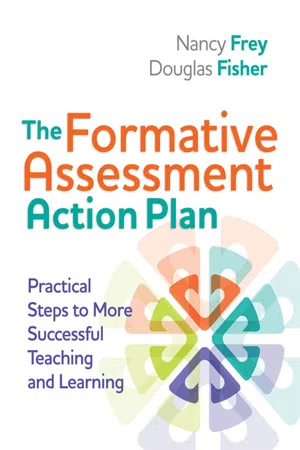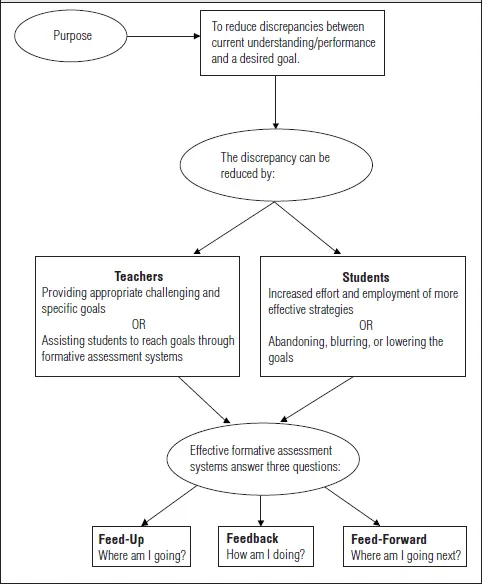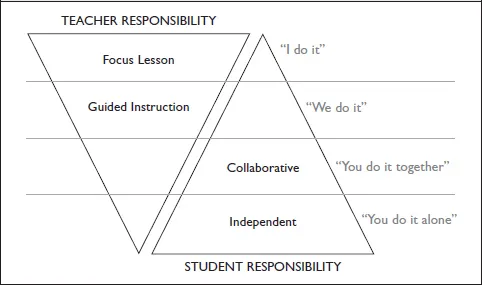![]()
Chapter 1
Creating a Formative Assessment System
“I don’t know how you’re going to learn this, but it’s on the test,” said the professor of a graduate class on neuroanatomy that Doug was taking.
The teacher’s words clearly articulated one perspective about education: Students should study and learn the content assigned to them. Her statement suggested that the teacher’s job is to provide information and the students’ job is to learn it, whatever way they can. When his teacher implied that the responsibility for learning rested solely on the students, Doug’s confidence plummeted. Having looked at intricate pictures of the human brain, Doug was already questioning how he was going to learn this information. Now his teacher was telling him that she, too, didn’t know how he (or any other student in the class) would learn it.
Understand that Doug was highly motivated to learn this content, and understand that his teacher was armed with the latest technology and instructional methods. The teacher was caring and passionate about her subject area, and, further, she had clearly communicated her high expectations at the outset of the course and summarized information weekly. Were these measures enough to ensure that Doug, and the other members of the class, reached high levels of understanding? Simply put, no. Even though high-quality instruction, innovative technology, motivation, high expectations, and passion are important in the teaching and learning process, they are not sufficient to ensure that learning occurs.
What was missing from this scenario—and from the entire class experience—was a formative assessment system. The teacher needed to establish learning goals, check for understanding, provide feedback, and then align future instruction with the students’ performance. She needed an instructional framework that allowed her to feed-forward, not just provide feedback.
A Formative Assessment System
Feedback, when used as part of a formative assessment system, is a powerful way to improve student achievement. Feedback by itself, though, is less useful. As John Hattie and Helen Timperley note, “Feedback has no effect in a vacuum; to be powerful in its effect, there must be a learning context to which feedback is addressed” (2007, p. 82).
Hattie and Timperley propose a formative assessment system that has three components: feed-up, feedback, and feed-forward (see Figure 1.1). Feed-up ensures that students understand the purpose of the assignment, task, or lesson, including how they will be assessed. Feedback provides students with information about their successes and needs. Feed-forward guides student learning based on performance data. All three are required if students are to learn at high levels. Each of these three components has a guiding question for teachers and students:
- Where am I going? (feed-up)
- How am I doing? (feedback)
- Where am I going next? (feed-forward)
Figure 1.1. A Formative Assessment System
Source: From Visible learning: A synthesis of over 800 meta-analyses relating to achievement (p. 176), by J. Hattie, 2009, New York: Routledge. Copyright 2009 by Routledge. Adapted with permission.
Imagine Doug’s teacher establishing the purpose for one of her classes, perhaps something like this: To use cytoarchitecture to identify locations in the cerebral cortex. She might then check for understanding, maybe through an audience response system, and provide individuals and the class with feedback. For example, she might ask, “Do the various regions of the brain contain the same number of cellular levels?” This dichotomous question has an answer (yes), and students would receive feedback about whether they had answered the question correctly. Based on the number of correct and incorrect responses, the teacher could decide what to feed-forward. The performance data from the class might suggest that the teacher needs to provide additional information and instruction to the whole class. Alternatively, the data might suggest that the teacher needs to ask specific students to elaborate on their answers so that she can determine the source of their misunderstanding. Then again, the data might suggest that the class has a good grasp on this content and is ready to move on.
When all three components of a formative assessment system are present, there is a give-and-take between teachers and students that facilitates learning. The absence of any one component places learning at risk. For example, when students do not understand the purpose of a lesson (feed-up), they are unlikely to demonstrate their best effort. Without a clear purpose, students are not motivated and do not see the relevance of the content they’re expected to master. When students are not assessed or do not receive assessment results (feedback), they are unsure about their performance and assume that they are doing just fine. They are unlikely to make mid-course corrections in their learning processes and understanding. When teachers fail to plan instruction based on student performance (feed-forward), misconceptions are reinforced, errors go unaddressed, and gaps in knowledge persist. Teachers march through their pacing guides and continue to “teach” while students passively observe. Unfortunately, when this is the case, teachers remain oblivious to the lack of real learning their students are doing.
Feedback Alone Is Not Enough
We have argued that formative assessment is a system with three inter-related components and that no one component alone is sufficient to ensure student learning. We want to take that one step further and focus on the ways in which feedback by itself is problematic. We have already noted that feedback should not be used in a vacuum. In part, this is because feedback is external to the learner; it is “external regulation,” meaning that a student is responding because of something happening to him or her from the outside, rather than responding intrinsically or internally (Ryan & Deci, 2000). Although students may occasionally use external feedback in their internal regulations, it takes more than feedback to ensure that internal regulation occurs.
External regulation is not the only reason that isolated feedback is ineffective. Another reason is that it transfers responsibility for further learning and performance improvement back to the learner. Consider the ubiquitous research paper. Students typically work on these projects for an extended length of time, maybe even getting peer editing and feedback. Finally, the due date arrives, and the teacher takes the stack of papers home to grade. Some days later, the papers are returned with feedback. What do students do with this feedback? Anyone who’s been in school knows that students either recycle the paper or, if required, make the noted changes and resubmit the paper for another round of review. The teacher has likely spent a great deal of time writing comments, but this time seems wasted when students throw away their work or simply correct the mistakes the teacher identified for them. They haven’t really learned from their mistakes.
The problem bears repeating. Feedback reassigns responsibility back to the learner. Think of a recent project on which you have received feedback. After you received the feedback, did you realize that it was, once again, up to you to figure out the next steps? Were you frustrated with this experience? Did you say to yourself, “Now I have to create another one, only to be judged again? Why can’t she just tell me what she wants?” If this has happened to you, you’ve experienced the abrupt shift of responsibility that we’re talking about.
This is not to say that we don’t want students to assume increasing responsibility; we do. It’s just that increasing responsibility should be planned, based on student confidence and competence. We don’t want students to suddenly be responsible for the first time when they make mistakes. Rather, a sophisticated formative assessment system built on a solid instructional framework should be in place from the beginning.
The Gradual Release of Responsibility Framework
A formative assessment system is only as good as the instructional framework on which it rests. No formative assessment system can compensate for poor instruction. Neither does simply having an instructional framework ensure that students will learn; both a framework and a system are required. The instructional framework we recommend is based on a gradual release of responsibility from teachers to students (Fisher & Frey, 2008a; Pearson & Gallagher, 1983) and includes five distinct components (see Figure 1.2).
Figure 1.2. Gradual Release of Responsibility
Source: From Better learning through structured teaching: A framework for the gradual release of responsibility (p. 4), by D. Fisher and N. Frey, 2008, Alexandria, VA: ASCD. Copyright 2008 by ASCD. Reprinted with permission.
Establishing Purpose
Every lesson must have an established purpose. This purpose can be in the form of a goal or objective, provided that the students know what that goal or objective is. The established purpose can have different components, such as content versus language (which will be more fully addressed in Chapter 2). Establishing purpose is important for many reasons, including alerting students to important information and keeping the teacher from getting off topic by discussing tangential information. In a formative assessment system, the purpose drives both feedback and feed-forward. Most people agree that it’s not fair to assess or test students on things that haven’t been taught. Sometimes students don’t get the purpose of the lesson, and, in those cases, it’s not fair to assess students on things that haven’t been clearly established as important.
Consider these two examples. In one classroom, the teacher has students working on projects, but they don’t know why or what is expected of them. There is no learning goal or purpose. In this class, the feedback students receive may be meaningless. In another classroom, the teacher has students working on projects with a clearly communicated purpose: to understand how sonar is used to determine water depths. When the teacher checks for understanding, the feedback is aligned with this purpose and the teacher can provide additional instruction to students who make errors, feeding forward until they understand the content.
Teacher Modeling
School is more than a pile of discrete facts that students have to memorize; it’s about thinking, questioning, and reflecting. As apprentices, students need examples of the kinds of thinking that experts do in order to begin to approximate those habits of mind. Thinking is a complex cognitive process that is largely invisible. To make it visible, teachers model through a think-aloud in which they “open up their minds” and let students see how they go about solving the various problems of school, from quadratic equations to decoding a word. As Gerald Duffy points out, “The only way to model thinking is to talk about how to do it. That is, we provide a verbal description of the thinking one does or, more accurately, an approximation of the thinking involved” (2003, p. 11).
In a formative assessment system, teacher modeling serves to highlight the processes that students should use to complete tasks and assignments. It’s less about the specific content and more about the ways in which experts in different disciplines go about their work. As we will explore in greater detail, formative assessment systems require attention to more than the correct response. Feedback and feed-forward also focus on the processes that students use as learners and thinkers, as well as their self-regulation and self-monitoring. Teacher modeling, through think-alouds, can provide students with examples of “self-generated thoughts, feelings, and actions that are planned and cyclically adapted to the attainment of personal goals” (Zimmerman, 2000, p. 14) such that students are responding to the feedback and future instruction they receive about learning.
Guided Instruction
In each lesson, the teacher must guide students toward increased understanding. This happens through the systematic use of questions, prompts, and cues. In this phase, questions are used to check for understanding. When a student’s response indicates a misconception or an error, the teacher prompts the student. Prompts are cognitive or metacognitive and focus on getting the learner to think. If prompts fail to resolve the misconception or error, the teacher provides a cue. Cues shift the learner’s attention to a resource that may help. As we will see in greater detail in Chapter 5, guided instruction is difficult to do in a whole-class format and works better in addressing the needs individual students present as they learn.
In a formative assessment system, guided instruction is an opportune time to provide students with feedback while also providing additional instruction. In this way, guided instruction plays a pivotal role in a formative assessment system as teachers feed-forward instruction based on real-time student responses. Consider the following exchange between a teacher and a small group of students having difficulty with the concept of writing mathematical sentences as inequalities.
Teacher: Tell me more about your answer. Read to me what you’ve written.
Alexis: The sentence says “Twenty minus the product of four and a number x is less than four.” [20 - 4x < 4]
Teacher: Yes, it does. So what did your group write on the chart paper?
Brandon: Right here. [points]
Teacher: Can you read that to me? Not from the projector but from your chart paper?
Justin: We wrote twenty minus four plus x is less than four. [20 - 4 + x < 4]
Teacher: Did that sound the same as when Alexis read it?
All: Yeah?
Teacher: Think about the word product.
Alexis: That’s to multiply.
Justin: But we didn’t multiply.
Brandon: Where do we multiply?
Alexis: Maybe right here? [points to the minus sign]
Teacher: Be careful. You might want to read it again.
Alexis: Twenty minus the product of four and a number x is less than four. Oh, wait, first we have to write 20 and then minus.
Justin: Then it says product, so we have to multiply. But you can’t have multiply next to minus.
Teacher: [Cups her hands around the words “the product of four and a number x.”]
Brandon: Wait. Look. It’s 4x, not minus four plus x.
Alexis: Oh, it’s 20 - 4x < 4. That’s right, huh?
Justin: It is, now read it again. It’s just like the sentence up there. [points to projected problem set]
This brief exchange allows the teacher to prompt and cue such that students experience success and complete the task. Will they need additional instruction? Probably. That’s what formative assessment systems are all about: reducing discrepancies between current understandings and a desired goal (Hattie, 2009). Feedback alone would probably not have resulted in new understanding.
Productive Group Work
Though students stand to learn a lot from and with their teachers, they are unlikely to consolidate that understanding unless they also work alongside peers in creating and producing something. Importantly, creating is now considered the highest-order thinking task in the Bloom’s taxonomy revised for the 21st century (see Figure 1.3). Creating something requires that students use their prior knowledge in new ways and that they rally resources to complete the task. As Matthew Crawford argues in Shop Class as Soulcraft (2009), thinking ...


